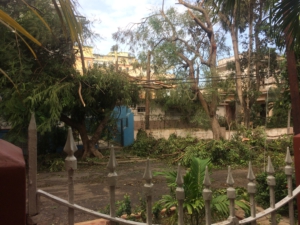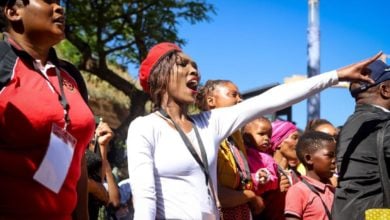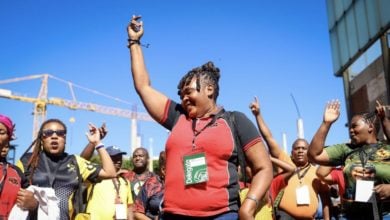The author was in a study abroad program in Havana during Hurricane Irma.

Leading up to Hurricane Irma, practically no one in Havana seemed worried. No one seemed worried for the sole reason that they were prepared for it, not, as I had mistakenly believed, because the hurricane was not supposed to hit Havana hard. As a powerful tropical storm, it did in fact hit the city very hard, and I had an experience I will never forget.
Before the storm hit, the U.S. media was painting such a dramatic image of Irma that a few mornings before Irma we received news that we might have to evacuate the island (in the end we never did). On the other hand, every Cuban I talked to dismissed the hysteria and insisted that the city would be fine. “No te procupes,” (“don’t worry”), they told me, “en Cuba, tenemos lo mejor sistema de preparación en el mundo” (“In Cuba, we have the best system of preparation in the world.”) They had the record to back up this claim. Cuba’s history of preparedness and disaster relief is well known, and ultimately this, along with the knowledge that the eye of the hurricane would not directly hit Havana, were two of the reasons our program directors made the decision to let us stay sheltered in our Cuban house during the storm.
Instead of leaving like most other study abroad programs, we stayed in Cuba and joined our neighbors in handling preparations. By the time of the hurricane, we had gone over emergency precautions several times, talked logistics with professors from the University of Havana and CEHSEU, (the Center for Hemispheric Studies and Studies of the United States,) and used WiFi one last time (the next time we would have access to internet would be four days later.)
Meanwhile, other students on my trip had quickly made one last trip to Habana Vieja (“Old Havana”) to get fans, (correctly) anticipating that our house would lose air conditioning in the coming days. At the same time, I noticed Cubans preparing more seriously, by carrying huge jugs of waters and crates of foods through the streets, working together to cut down branches, checking the news constantly to track the destructive path of the hurricane. Through it all, however, no one was panicking. Instead, everyone was moving in a calm manner and seemed ready to take on whatever was to come. And, as one of the few study abroad programs that let their students stay, the five of us in my program were with them, awaiting the unknown but ready for whatever.
Starting on Friday evening, we, the five students of the program and our residential director Angélica, were stuck inside our house watching the first rain showers come down. By Saturday afternoon, the rain and wind had picked up considerably, and anticipating fallen wires and other problems, the city cut our electricity, water and dial-up Internet connection. The next time we would have electricity or running water would be on Tuesday. In retrospect, this was probably the toughest part — we had to use bucket water for showers and toilets, had no air conditioning in tropical weather conditions and had to use flashlights to get around in the evenings. But it was still easier for us than it was for our neighbors, because we at least had access to water through a spigot in the back and had food the whole time. The storm was heavy, especially during Saturday night, but we stayed inside and I was never too worried, partly because our only contact with it was behind closed windows and doors.
When we left the house for the first time Sunday evening during sunset, I was shocked by the damage I saw around me. Immediately outside of our house were two fallen trees that had knocked down electricity wires. As we walked down the hill towards the ocean, we found much of the same. Closer to sea-level, the first several streets were flooded and we could only go so far. Looking way down the road, we could see huge (perhaps 20-feet-high) waves crash over the walls lining the Malécon (the street next to the ocean).
Incredibly, as we surveyed the damage done, we saw several Cubans out and about. At first, we just saw people doing the same thing we were doing — walking around and looking at the aftermath of the storm. By the next afternoon, even without electricity or running water, the crowds in the streets grew and the vibrant city started coming back to life. Teenagers were playing ball, maquinas (the cooperative taxis shared by many Cubans at once along the major roads) were picking up and dropping off passengers, and a photo of Cuban men playing dominoes while sitting in waste-high water went viral. While private companies engaged in price-gouging in Puerto Rico and Florida, in Cuba the state-owned restaurants and stores lowered prices in the aftermath of the hurricane so that as many people as possible could have access to the goods.
The National Cuban Civil Defense units were already in the streets Sunday night and by Monday dozens of organizations and individuals joined them in raking leaves, repainting walls, dealing with loose cable and more. We did what we could to help out with the recovery, joining our neighbors in cleaning up the branches, leaves and debris on our street and in the area surrounding CEHSEU. By the time the other study abroad programs that had evacuated returned a few days later, electricity and water had already been returned to virtually everyone in the city, and except for the area around the Malécon (which would take a bit longer to re-open), everything was back to normal.
In the aftermath of one of the biggest storms on record, I was amazed by the displays of resilience and community I saw around me. Serious preparation and extremely well coordinated recovery efforts assured that the people of Havana were safe and could live their lives the same as before – a far cry from the tragic situation in Puerto Rico, where months later parts of the capitol city are still without electricity. Whereas the severe and lasting damage from the hurricanes in Puerto Rico fill me with sadness, the effective response and miraculous recovery from Hurricane Irma in Cuba fill me with hope and prove to me that with ample preparation and a well-organized response system, the damage of natural disasters can be greatly lessened and catastrophes avoided.





